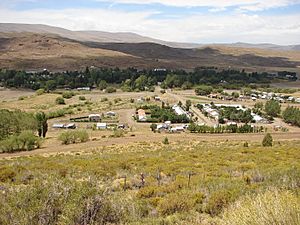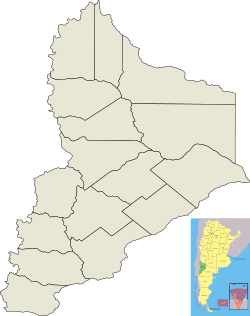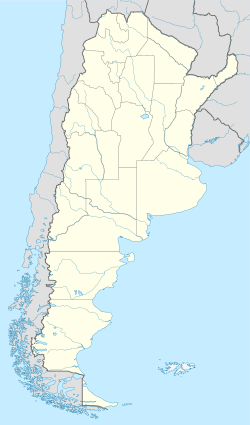El Huecú facts for kids
Quick facts for kids
El Huecú
|
|
|---|---|

El Huecú as of 2008
|
|
| Country | |
| Province | Neuquén Province |
| Department | Ñorquín Department |
| Founded | October 20, 1915 |
| Elevation | 1,569 m (5,148 ft) |
| Population
(2010 census [INDEC])
|
|
| • Total | 1,391 |
| Time zone | UTC−3 (ART) |
| CPA Base |
Q 8349
|
| Area code(s) | +54 02948 |
| Climate | Csb |
El Huecú is a small town in the northern part of Neuquén Province in Argentina. It's the main town of the Ñorquín Department. The town was officially founded in 1940.
Goat breeding is very important to the local economy. Because of this, El Huecú hosts a special event every year called the Festival of the Shepherd.
Contents
History of El Huecú
The area where El Huecú is located has an interesting past. The first capital of the department was a city called Ñorquín. It had over 1,000 people living there. The first local election happened in 1886.
However, Ñorquín was built on private land. Over time, people started moving from Ñorquín to the new location of El Huecú. This new town was approved on September 2, 1938.
In 1940, the Argentine government officially made El Huecú the new capital of the department. The town's local government building was built in 1973. In 1976, El Huecú became a "third-category municipality," which is a type of local government status it still has today.
El Huecú is one of the towns in northern Neuquén that uses a "participative budget." This means local people can help decide how some of the town's money is spent. Since 2004, the Mapuche people are recognized as the original inhabitants of this region.
What Does El Huecú Mean?
The name "El Huecú" comes from the Mapudungun language. This is the language spoken by the Mapuche people. The word means "evil genius."
The Mapuche people used this word to describe a type of bunchgrass called Vulpia octoflora.
Geography and Nature
El Huecú is located in the northwest of Neuquén Province. It is about 370 kilometers (230 miles) from the city of Neuquén. It is also 90 kilometers (56 miles) from Chos Malal. You can find it on Provincial Road 4.
The town sits in a wide valley. This valley was shaped by the El Huecú creek and other natural forces. It is surrounded by the Mandolegue and Trocomán mountain ranges. The town is about 1,200 meters (3,937 feet) above sea level.
The area around El Huecú is mostly a semi-desert. You can find many types of bushes there. However, pine forests have been planted near the town.
The animals living in this region are quite interesting. You might see ostriches, guanacos, mountain lions, foxes, and rabbits. Many birds live here too, including the amazing Andean condor, vultures, and different kinds of sparrows.
Population of El Huecú
In 2016, it was estimated that about 2,194 people lived in the El Huecú area. According to the 2010 Argentine census, the town had 1,391 residents. This was very similar to the 1,399 people counted in 2001.
Looking back, the population has grown a lot. In 1970, only 255 people lived there. By 1980, it grew to 743 people, and by 1991, there were 1,149 residents.
It is believed that about 40% of the people in El Huecú are of Mapuche descent. Many people in the town work for the government. Others work for private businesses, mostly in the service industry.
Festival of the Shepherd
Goat breeding is a very important part of the local economy in El Huecú. Every December, the town celebrates the "Festivity of the Shepherd." In Spanish, this festival is called Fiesta del Criancero.
This festival honors the local goat shepherds. These shepherds still practice transhumance. This means they move their goats from one grazing area to another depending on the season.
See also
 In Spanish: El Huecú para niños
In Spanish: El Huecú para niños



